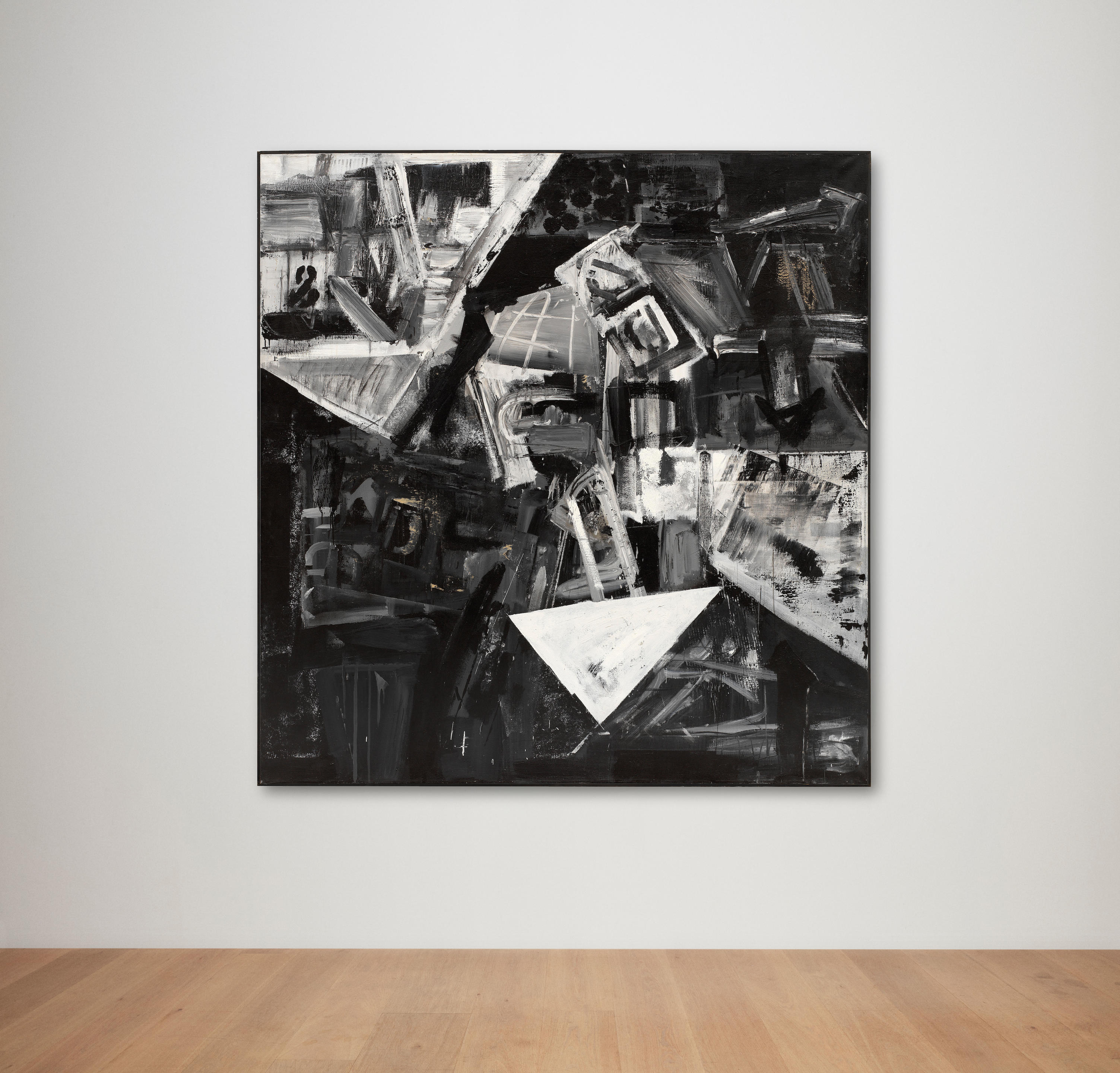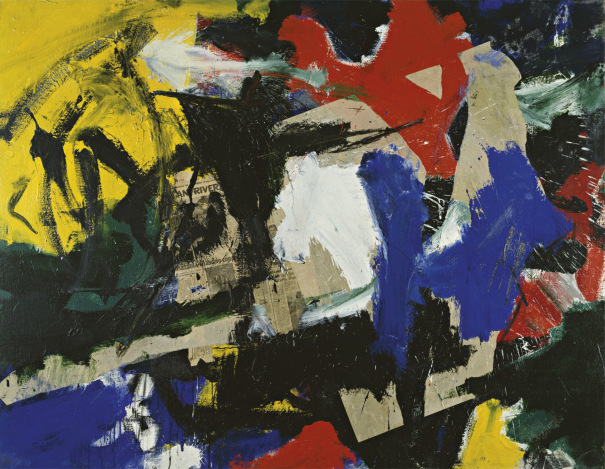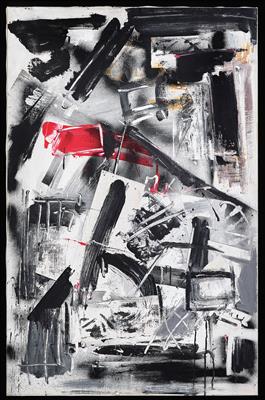Emilio Vedova Presenza N7V oil and charcoal on canvas 201.2 x 86.5 cm (79 1/4 x 34 in.) Painted in 1959, this work is registered with the Fondazione Emilio e Annabianca Vedova under archive number FV50.
Provenance Galleria Blu, Milan Private Collection, Milan (acquired from the above in 1960) Thence by descent to the present owner Catalogue Essay Bursting in a rich and dramatic movement of marks, Presenza N7V stands as one of the most engaging examples of gestural paintings from the European artistic scene of the late 1950s. It represents a symbol of political freedom at a time when Italy had been plunged into the aftermath of the devastation caused by Fascism. In the fervent and highly politicized debate between realism and abstraction of the post-war Italy, Vedova emerged as one of its major protagonists. Starting his career as a self-taught artist, Vedova joined the solid cultural renovation proposed by groups such as Corrente or Gruppo degli otto pittori italiani who refused to subjugate the realistic style of the nineteenth-century. Nonetheless, he soon stood out for building his own genuine language and remaining utterly faithful to it, in spite of the various changes that necessarily sprang from his moving with the times. In 1959, Vedova experienced a period of transition, whereby his forms drifted away from an initial figurative and geometric tendency, explaining 'I step out of a personal, inner crisis: I rebel against all geometry, the dominant rigor in my paintings and I try to shake my work towards a more spontaneous direction' (Emilio Vedova quoted in Germano Celant, Vedova 1935-1984, Milan, 1984, p. 35). As Presenza N7V fiercely demonstrates, Vedova embraced a more fragmentary and aggressive visual language, characterized by vortices of destructive energy, fluxes of centripetal and centrifugal movements, where the sign is no longer decipherable. Herein the Cubist geometric strictness of his early period is tempered with a sense of profound emotional involvement and the work is animated with the same convulse dynamism and feverishness that was central to the Futurist practice, the difference being that his violent canvases are not a hymn to modern times, but rather they convey – in abstract terms – the feelings of grief and distress that pervaded his society. Vedova believed in the purity of art that could on its own lead to redemption. Therefore Presenza N7V can be considered as the artist’s intimate response to the broken world he was living in, which could only be depicted through gestural abstractions. It is this ethic and poetic consistency that saved Vedova from burning himself out in the melting-pot of Informel and enabled him to authentically express himself. Read More
Emilio Vedova Presenza N7V oil and charcoal on canvas 201.2 x 86.5 cm (79 1/4 x 34 in.) Painted in 1959, this work is registered with the Fondazione Emilio e Annabianca Vedova under archive number FV50.
Provenance Galleria Blu, Milan Private Collection, Milan (acquired from the above in 1960) Thence by descent to the present owner Catalogue Essay Bursting in a rich and dramatic movement of marks, Presenza N7V stands as one of the most engaging examples of gestural paintings from the European artistic scene of the late 1950s. It represents a symbol of political freedom at a time when Italy had been plunged into the aftermath of the devastation caused by Fascism. In the fervent and highly politicized debate between realism and abstraction of the post-war Italy, Vedova emerged as one of its major protagonists. Starting his career as a self-taught artist, Vedova joined the solid cultural renovation proposed by groups such as Corrente or Gruppo degli otto pittori italiani who refused to subjugate the realistic style of the nineteenth-century. Nonetheless, he soon stood out for building his own genuine language and remaining utterly faithful to it, in spite of the various changes that necessarily sprang from his moving with the times. In 1959, Vedova experienced a period of transition, whereby his forms drifted away from an initial figurative and geometric tendency, explaining 'I step out of a personal, inner crisis: I rebel against all geometry, the dominant rigor in my paintings and I try to shake my work towards a more spontaneous direction' (Emilio Vedova quoted in Germano Celant, Vedova 1935-1984, Milan, 1984, p. 35). As Presenza N7V fiercely demonstrates, Vedova embraced a more fragmentary and aggressive visual language, characterized by vortices of destructive energy, fluxes of centripetal and centrifugal movements, where the sign is no longer decipherable. Herein the Cubist geometric strictness of his early period is tempered with a sense of profound emotional involvement and the work is animated with the same convulse dynamism and feverishness that was central to the Futurist practice, the difference being that his violent canvases are not a hymn to modern times, but rather they convey – in abstract terms – the feelings of grief and distress that pervaded his society. Vedova believed in the purity of art that could on its own lead to redemption. Therefore Presenza N7V can be considered as the artist’s intimate response to the broken world he was living in, which could only be depicted through gestural abstractions. It is this ethic and poetic consistency that saved Vedova from burning himself out in the melting-pot of Informel and enabled him to authentically express himself. Read More













.jpg)

Testen Sie LotSearch und seine Premium-Features 7 Tage - ohne Kosten!
Lassen Sie sich automatisch über neue Objekte in kommenden Auktionen benachrichtigen.
Suchauftrag anlegen